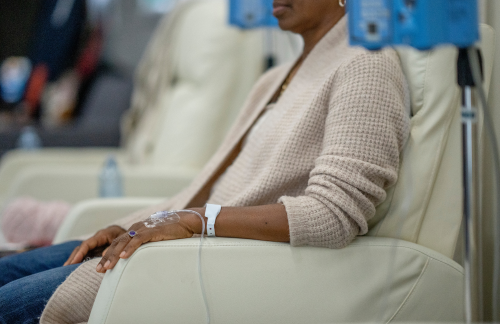
19 Dec, 2025
Feel free to reach out to us.

19 Dec, 2025

This article is medically reviewed by Dr. Kshitij Domadia, Consultant - Medical Oncology, HCG Aastha Cancer Centre.
Chemotherapy is a type of treatment recommended for patients diagnosed with different types of cancer. Chemotherapy involves delivering potent drugs that kill the rapidly growing cells in the body, including tumor or cancer cells.
Several types of chemotherapy treatments are available for the effective management of different types and stages of cancer. Patients with an early diagnosis of cancer have a more favorable prognosis with chemotherapy.
Most patients receive a combination of different chemotherapy drugs for enhanced treatment effectiveness. HCG, one of the best cancer hospitals in India, offers advanced chemotherapy options for patients dealing with a wide range of cancers.
In this article, let’s try to understand different types of chemo, the criteria on which they are categorized, how to prepare for chemotherapy, and lastly, the aftermath of chemotherapy treatments.
The oncologists at HCG have specialized expertise in delivering chemotherapy drugs through various routes, such as oral, intravenous, and intramuscular administration.
The intravenous delivery of the drugs can be through a port, needle, catheter, or pump. Chemotherapy is generally administered in multiple cycles, and their number may vary from one case to another.
In most cases, the administration of drugs occurs within a few minutes to a few hours. However, some patients may require continuous drug infusions that may take a few days, depending on the chemotherapy treatment protocol for a particular cancer.
Continue reading to discover the various types of chemo and how they are administered.
The chemotherapy treatment has evolved significantly in recent years. We have multiple chemotherapy drug options today for different types of cancer. Medical oncologists choose the most suitable drug for each case, depending on the type and stage of the disease. In addition, the response to previous treatment also affects the choice of further treatment.
Chemotherapy drugs are categorized into different classes based on their mode of action against cancer cells. These include alkylating agents, anti-metabolites, plant alkaloids, and topoisomerase inhibitors. These drugs target the essential pathways in cancer cells and prevent their growth and multiplication.
Chemotherapy may or may not be combined with other treatment approaches, like surgery, radiotherapy, immunotherapy, and targeted therapy for enhanced effectiveness.
There are various applications of chemotherapy in cancer management. These include:
The types of chemotherapy treatments may be classified based on their mechanisms of action against cancer cells. The following are the different types of chemotherapy drugs:
These agents interfere with the process of multiplication of cancer cells by damaging DNA. The cancers treated with alkylating agents include lymphoma, multiple myeloma, breast cancer, lung cancer, and ovarian cancer.
These agents interfere with cell replication and proliferation by substituting RNA and DNA with amino acids. The cancers treated with antimetabolites include ovarian cancer, breast cancer, and leukemia.
Topoisomerase is an enzyme that untangles DNA. Replication of DNA can only take place after untangling. Topoisomerase inhibitors block the enzyme and prevent DNA replication.
These drugs are also known as mitotic inhibitors. They inhibit mitosis and prevent the cancer cells from dividing. Cancers treated with plant alkaloids include myeloma, lymphoma, leukemia, and breast cancer.
This class of chemotherapy drugs interferes with DNA replication, just like alkylating agents, and controls the growth of cancer cells.
This drug crosses the blood-brain barrier, making it an effective drug to treat different types of brain malignancies.
The antibiotics obtained from the bacterium, Streptomyces, have anti-cancer properties and are used as part of chemotherapy treatment for some cancers. This chemo drug works by causing DNA damage or preventing DNA synthesis.
The types of chemotherapy treatment may be divided based on routes of administration. These include:
It is one of the most common routes for delivering chemo drugs or common chemotherapy types. The route of administration is vein or blood vessel. It is usually given in drip form.
The route of administration of the drug involves muscles. Intramuscular chemotherapy is often administered in the upper arm, buttocks, or upper thigh.
Oral administration of these drugs may be in the form of tablets or capsules.
This route is generally chosen for delivering drugs to patients with skin cancer and precancerous lesions. These formulations are available in the form of creams and gels, which can be applied to the target site as prescribed by the specialist.
This route of chemotherapy administration involves direct administration of the drugs into the abdominal cavity to treat cancers of the abdominal organs, particularly the peritoneum.
Hyperthermic intraperitoneal chemotherapy (HIPEC) is a specialized form of chemotherapy used to manage cancers that develop in the abdominal area. In the first stage, the surgical oncologist performs the surgery to remove the tumor as much as possible. Then heated chemotherapy drugs are delivered into the abdominal cavity through the catheters.
Intravesical chemotherapy comprises the administration of chemotherapy drugs into the urinary bladder through cystoscopy. It is used for the treatment of bladder cancer.
Intrapleural chemotherapy involves the administration of anticancer drugs in the chest cavity/pleura to treat lung cancer.
Intrathecal chemotherapy drugs manage cancers of the brain and spinal cord. The drug is delivered into the intrathecal space.
Some measures may help the patients effectively prepare for medical oncology treatment. These include:
Care after chemotherapy treatment is important. It helps the patient prepare for the next chemotherapy session and improves the quality of life. Some care tips during and after medical oncology treatment include
Several factors affect the efficacy of chemotherapy treatment. These include types and stages of cancer, response to treatment, severity of side effects, age of the patient, and overall health/performance status.
Further, oncologists critically monitor the effect of chemotherapy, and based on the evaluation, they may continue the treatment, add more drugs to the treatment regimen, or switch the patient to another treatment option. Upon completing their chemotherapy treatment, patients need to keep up their follow-up appointments, which can help them achieve long-term remission and reduce the risk of recurrences.
Chemotherapy treatment may cause both short- and long-term side effects. Most of these side effects subside on their own within a span of a few weeks. However, if these side effects are severe, patients must reach out to their expert team. Different short-term side effects include:
The long-term side effects of chemotherapy include:
Chemotherapy plays a vital role in the management of cancer. It targets and kills cancer cells. It improves the survival rate for several types of cancer, especially when cancer is diagnosed early. The factors affecting the choice of chemotherapy include the type and stage of cancer, treatment goals, and the patient's overall health. In some cases, patients can receive their chemotherapy infusion on an outpatient basis, which causes fewer disruptions to their day-to-day life.
SEER Training: Introduction to Chemotherapy
SEER Training: Types of Chemotherapy Drugs
Chemotherapy to Treat Cancer - NCI
Types of Cancer Treatment - NCI

Dr. Kshitij Domadia
Consultant - Medical Oncology
MBBS, MD (Internal Medicine), DNB (Medical Oncology), ECMO
Dr. Kshitij Domadia is an ESMO (European Society of Medical Oncology)-certified medical oncologist (ECMO) with a special interest in the management of lung cancers, head and neck cancers, genitourinary cancers, and breast cancers. He is available for consultations at HCG Aastha Cancer Centre, a leading oncology hospital in Ahmedabad. He is an expert in dealing with all sorts of chemotherapy, targeted therapy, and immunotherapy in its most rational manner. His expertise in dealing with molecular aspects of oncology and precision oncology is very well acclaimed by the community. Dr. Kshitij approaches his patient care with empathy, care, and compassion, in addition to his thorough academic knowledge.
To book an appointment with Dr. Kshitij Domadia, please click here.